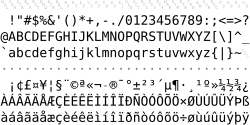
Back Latin-1 Catalan ISO 8859-1 Czech ISO 8859-1 Danish ISO 8859-1 German ISO 8859-1 Esperanto ISO/IEC 8859-1 Spanish ایزو/آیئیسی ۸۸۵۹–۱ Persian ISO 8859-1 Finnish ISO/CEI 8859-1 French ISO 8859-1 FRR
 ISO/IEC 8859-1 code page layout | |
| MIME / IANA | ISO-8859-1 |
|---|---|
| Alias(es) | iso-ir-100, csISOLatin1, latin1, l1, IBM819, CP819 |
| Language(s) | English, various others |
| Standard | ISO/IEC 8859 |
| Classification | Extended ASCII, ISO/IEC 8859 |
| Extends | US-ASCII |
| Based on | DEC MCS |
| Succeeded by | |
| Other related encoding(s) | |
ISO/IEC 8859-1:1998, Information technology—8-bit single-byte coded graphic character sets—Part 1: Latin alphabet No. 1, is part of the ISO/IEC 8859 series of ASCII-based standard character encodings, first edition published in 1987. ISO/IEC 8859-1 encodes what it refers to as "Latin alphabet no. 1", consisting of 191 characters from the Latin script. This character-encoding scheme is used throughout the Americas, Western Europe, Oceania, and much of Africa. It is the basis for some popular 8-bit character sets and the first two blocks of characters in Unicode.
As of July 2024[update], 1.2% of all web sites use ISO/IEC 8859-1.[1][2] It is the most declared single-byte character encoding, but as Web browsers and the HTML5 standard[3] interpret them as the superset Windows-1252, these documents may include characters from that set. Depending on the country or language, website use can be higher than the global average, in Brazil it is at 3.4%,[4] and in Germany at 2.7%.[5][6]
ISO-8859-1 was (according to the standard, at least) the default encoding of documents delivered via HTTP with a MIME type beginning with text/, the default encoding of the values of certain descriptive HTTP headers, and defined the repertoire of characters allowed in HTML 3.2 documents. It is specified by many other standards.[example needed] In practice, the superset encoding Windows-1252 is the more likely effective default[7] and it is increasingly common for standards to (at least unofficially)[clarification needed] default to UTF-8.
ISO-8859-1 is the IANA preferred name for this standard when supplemented with the C0 and C1 control codes from ISO/IEC 6429. The following other aliases are registered: iso-ir-100, csISOLatin1, latin1, l1, IBM819. Code page 28591 a.k.a. Windows-28591 is used for it in Windows.[8] IBM calls it code page 819 or CP819 (CCSID 819).[9][10][11][12] Oracle calls it WE8ISO8859P1.[13]
- ^ "Historical trends in the usage statistics of character encodings for Web sites, July 2024". W3Techs. Archived from the original on 4 April 2024. Retrieved 2024-07-19.
- ^ Cowan, John; Soltano, Sam (August 2014). "Source of character encoding statistics?". W3Techs. Archived from the original on 4 April 2024.
- ^ "Encoding". WHATWG. 27 January 2015. sec. 5.2 Names and labels. Archived from the original on 4 February 2015. Retrieved 4 February 2015.
- ^ "Distribution of Character Encodings among websites that use Brazil". W3Techs. Archived from the original on 4 April 2024. Retrieved 2024-07-19.
- ^ "Distribution of Character Encodings among websites that use .de". W3Techs. Archived from the original on 4 April 2024. Retrieved 2024-07-19.
- ^ "Distribution of Character Encodings among websites that use German". W3Techs. Archived from the original on 4 April 2024. Retrieved 2023-01-16.
- ^ "c++ - What is the native narrow string encoding on Windows?". Stack Overflow. Jan 2011. Retrieved 2023-02-16.
- ^ "Code Page Identifiers". Microsoft Corporation. Retrieved 2010-12-19.
- ^ "Code page 819 information document". Archived from the original on 2017-01-16.
- ^ "CCSID 819 information document". Archived from the original on 2016-03-27.
- ^ Code Page CPGID 00819 (pdf) (PDF), IBM
- ^ Code Page CPGID 00819 (txt), IBM
- ^ Baird, Cathy; Chiba, Dan; Chu, Winson; Fan, Jessica; Ho, Claire; Law, Simon; Lee, Geoff; Linsley, Peter; Matsuda, Keni; Oscroft, Tamzin; Takeda, Shige; Tanaka, Linus; Tozawa, Makoto; Trute, Barry; Tsujimoto, Mayumi; Wu, Ying; Yau, Michael; Yu, Tim; Wang, Chao; Wong, Simon; Zhang, Weiran; Zheng, Lei; Zhu, Yan; Moore, Valarie (2002) [1996]. "Appendix A: Locale Data". Oracle9i Database Globalization Support Guide (PDF) (Release 2 (9.2) ed.). Oracle Corporation. Oracle A96529-01. Archived (PDF) from the original on 2017-02-14. Retrieved 2017-02-14.